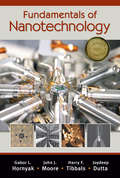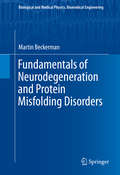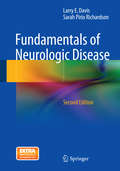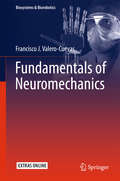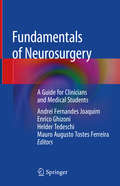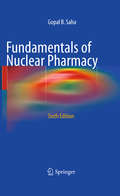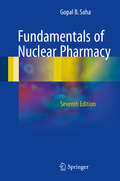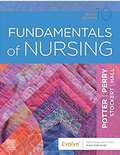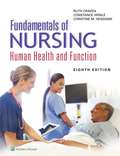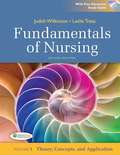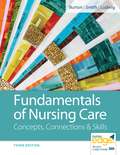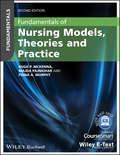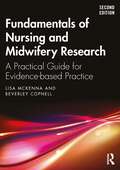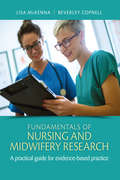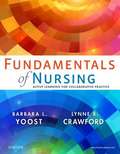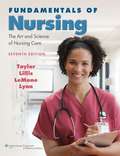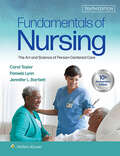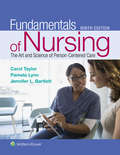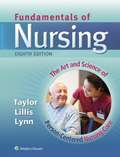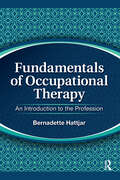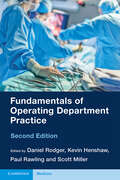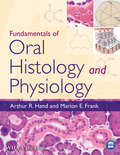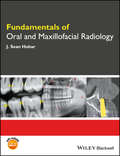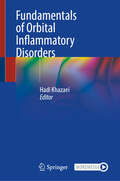- Table View
- List View
Fundamentals of Nanotechnology
by Gabor L. Hornyak John J. Moore H.F. Tibbals Joydeep DuttaWINNER 2009 CHOICE AWARD OUTSTANDING ACADEMIC TITLE! Nanotechnology is no longer a subdiscipline of chemistry, engineering, or any other field. It represents the convergence of many fields, and therefore demands a new paradigm for teaching. This textbook is for the next generation of nanotechnologists. It surveys the field’s broad landscape, exploring the physical basics such as nanorheology, nanofluidics, and nanomechanics as well as industrial concerns such as manufacturing, reliability, and safety. The authors then explore the vast range of nanomaterials and systematically outline devices and applications in various industrial sectors. This color text is an ideal companion to Introduction to Nanoscience by the same group of esteemed authors. Both titles are also available as the single volume Introduction to Nanoscience and Nanotechnology Qualifying instructors who purchase either of these volumes (or the combined set) are given online access to a wealth of instructional materials. These include detailed lecture notes, review summaries, slides, exercises, and more. The authors provide enough material for both one- and two-semester courses.
Fundamentals of Neurodegeneration and Protein Misfolding Disorders
by Martin BeckermanThis unique text introduces students and researchers to the world of misfolded proteins, toxic oligomers, and amyloid assemblages, and the diseases of the brain that result. During the past few years the connections between failures in protein quality control and neurological disorders have been reinforced and strengthened by discoveries on multiple fronts. These findings provide novel insights on how amyloidogenic oligomers and fibrils form, interconvert from one state to another, and propagate from cell to cell and region to region. Starting with protein folding and protein quality control basics, the reader will learn how misfolded proteins can cause diseases ranging from prion diseases to Alzheimer's disease and Parkinson's disease to Huntington's disease, amyotrophic lateral sclerosis and frontotemporal lobar degeneration. Authoritative but written in a clear and engaging style, Fundamentals of Neurodegeneration and Protein Misfolding Disorders addresses one of today's forefront areas of science and medicine. The text emphasizes the new groundbreaking biophysical and biochemical methods that enable molecular-level explorations and the conceptual breakthroughs that result. It contains separate chapters on each of the major disease classes. Special emphasis is placed on those factors and themes that are common to the diseases, especially failures in synaptic transmission, mitochondrial control, and axonal transport; breakdowns in RNA processing; the potential role of environmental factors; and the confounding effects of neuroinflammation. The book is ideal for use in teaching at the advanced undergraduate and graduate levels, and serves as a comprehensive reference for a broad audience of students and researchers in neuroscience, molecular biology, biological physics and biomedical engineering.
Fundamentals of Neurologic Disease
by Larry E. Davis Sarah Pirio RichardsonThis concise text delivers a basic introduction to neurology and is designed for use by medical students during their rotation in neurology and related disciplines. Updated and expanded, this second edition follows the same order as the first, starting with how to approach a patient with a neurologic problem followed by the latest information on the phenomenology, pathophysiology and symptoms of common adult and pediatric neurologic diseases. Supplementing the learning experience are clinical cases that begin each chapter and videos of examples ranging from how to perform the normal neurologic exam to abnormal exam findings. Easy-to-read and richly illustrated, Fundamentals of Neurologic Disease, 2nd Edition is an invaluable resource for anyone seeking to learn the fundamentals of neurology.
Fundamentals of Neuromechanics
by Francisco J. Valero-CuevasThis book provides a conceptual and computational framework to study how the nervous system exploits the anatomical properties of limbs to produce mechanical function. The study of the neural control of limbs has historically emphasized the use of optimization to find solutions to the muscle redundancy problem. That is, how does the nervous system select a specific muscle coordination pattern when the many muscles of a limb allow for multiple solutions? I revisit this problem from the emerging perspective of neuromechanics that emphasizes finding and implementing families of feasible solutions, instead of a single and unique optimal solution. Those families of feasible solutions emerge naturally from the interactions among the feasible neural commands, anatomy of the limb, and constraints of the task. Such alternative perspective to the neural control of limb function is not only biologically plausible, but sheds light on the most central tenets and debates in the fields of neural control, robotics, rehabilitation, and brain-body co-evolutionary adaptations. This perspective developed from courses I taught to engineers and life scientists at Cornell University and the University of Southern California, and is made possible by combining fundamental concepts from mechanics, anatomy, mathematics, robotics and neuroscience with advances in the field of computational geometry. Fundamentals of Neuromechanics is intended for neuroscientists, roboticists, engineers, physicians, evolutionary biologists, athletes, and physical and occupational therapists seeking to advance their understanding of neuromechanics. Therefore, the tone is decidedly pedagogical, engaging, integrative, and practical to make it accessible to people coming from a broad spectrum of disciplines. I attempt to tread the line between making the mathematical exposition accessible to life scientists, and convey the wonder and complexity of neuroscience to engineers and computational scientists. While no one approach can hope to definitively resolve the important questions in these related fields, I hope to provide you with the fundamental background and tools to allow you to contribute to the emerging field of neuromechanics.
Fundamentals of Neurosurgery: A Guide for Clinicians and Medical Students
by Andrei Fernandes Joaquim Enrico Ghizoni Helder Tedeschi Mauro Augusto Tostes FerreiraThe aim of this book is to provide clinicians and medical students with basic knowledge of the most common neurosurgical disorders. There is a vast array of signs and symptoms that every clinician should recognize as neurosurgical affectations, allowing them to identify when to refer the patient to a neurosurgeon. In this text, the editors intend to bridge the gap between clinical medicine and neurosurgery, making neurosurgical practice understandable to a wider medical public. The book provides a smooth transition from neuroanatomy, neurophysiology and neurological examination to neurosurgery, focusing more on the knowledge underlying neurosurgical practice rather than on surgical technique. The core of the book is composed of chapters discussing each of the most important medical conditions that deserve neurosurgical intervention, providing key information on diagnosis, clinical aspects, disease management, surgical procedures and prognosis. Moreover, complementary discussion of the frontiers and advances in neurosurgery are also covered. In this sense, this book has two main goals and intended audiences. First, and primarily, it is intended for clinicians in a wide array of non-surgical medical specialties (such as general practitioners, neurologists, pediatricians, oncologists and others) aiming to give an overview on important characteristics and initial management of the most prevalent disorders treated by neurosurgeons. Second, and to a lesser degree, it is intended to be used as a practical guide for medical students who are initiating their study in neurosurgical sciences. Fundamentals of Neurosurgery – A Guide for Clinicians and Medical Students intends to be a comprehensive guide for all non-neurosurgeons who want to broaden their knowledge of neurosurgery.
Fundamentals of Nuclear Pharmacy
by Gopal B. SahaEstablished as a classic text on nuclear chemistry and pharmacy, Fundamentals of Nuclear Pharmacy has been thoroughly revised with new information added covering innovations in imaging technology and clinical applications in the field. The Sixth Edition also eliminates outdated information from previous editions on radiopharmaceuticals now discontinued from the market. Dr. Gopal B. Saha's books have continually been praised for their clarity and accuracy while setting new standards for making complex theoretical concepts readily understandable to the reader. Like past editions, this book is intended to be used as a textbook on nuclear chemistry and pharmacy for nuclear medicine residents and students and as a reference book for nuclear medicine physicians and radiologists. New sections in the Sixth Edition include: * PET/CT and SPECT/CT * Digital Imaging * Exploratory IND * Nanoparticle Imaging * Treatment of liver cancer with 90Y-TheraSpheres and 90Y-SIR-Spheres * Treatment of Non-Hodgkin's lymphoma with 131I-Bexxar
Fundamentals of Nuclear Pharmacy
by Gopal B. SahaNuclear medicine is an ever changing subject, and the emphasis and utility of one type of study is often abruptly supplanted by another. In this unstable environment, there is a set of circumstances that offers a basic unifying structure to the activities encountered in nuclear medicine. The pivotal importance of radio pharmaceuticals in these activities makes a thorough understanding of them paramount for all who would prescribe, dispense, or in any way utilize such materials. In this volume, the author has distilled an awesome body of literature on nuclear pharmacy into a concise and readily understandable textbook. It is written from the viewpoint of one who not only has broad experience and knowledge in nuclear pharmacy, who daily guides and instructs a variety of students in the discipline, but who also directs a clinical nuclear medicine radiopharmacy program. In this book he has avoided the esoteric and maintained an emphasis on the practical. The approach is not encyclopedic in nature, as adequate references refer the more interested reader to appropriate sources of detailed information, but one which ensures that the students will be able to absorb the essentials of nuclear pharmacy and practice it effectively with a broad understanding of the subject. At the end of each chapter a set of questions provokes the reader to assess the sufficiency of the knowledge gained.
Fundamentals of Nursing
by Amy Hall Patricia A. Potter Anne Griffin Perry Patricia StockertLearn the concepts and skills you need to provide excellent nursing care! Fundamentals of Nursing, 10th Edition prepares you to succeed as a nurse by providing a solid foundation in critical thinking, clinical reasoning, nursing theory, evidence-based practice, and patient-centered care in all settings. <p><p>With illustrated, step-by-step guidelines, this book makes it easy to learn important skills and procedures. Care plans are presented within a nursing process framework, and case studies show how to apply concepts to nursing practice. <p><p>From an expert author team led by Patricia Potter and Anne Perry, this bestselling nursing textbook helps you develop the understanding and clinical reasoning you need to succeed in the classroom and in your career.
Fundamentals of Nursing (Eighth Edition)
by Constance J. Hirnle Christine M. Henshaw Ruth CravenPublisher's Note: Products purchased from 3rd Party sellers are not guaranteed by the Publisher for quality, authenticity, or access to any online entitlements included with the product. Fundamentals of Nursing: Human Health and Function gives students the knowledge, tools, and problem-solving skills they need to tackle real-life challenges in today's fast-paced clinical settings. In addition to focusing on basics such as how to promote health, differentiate between normal function and dysfunction, use scientific rationales, and follow the approved nursing process, this practical book goes a step further by providing something just as valuable: an understanding of patient safety, communication, and critical thinking, all of which successful nurses must demonstrate. Highlights of the 8th Edition: A timely new chapter--Chapter 4, The Nurse's Role in Healthcare Quality and Patient Safety--responds to multiple imperatives in today's health care, helping students understand systems that promote exceptional care in a complex environment. Case scenarios that open each chapter show nurses thinking holistically and reflecting on critical thinking questions. All-new, richly illustrated concept maps, ideal for visual learners, apply the nursing process and critical thinking to the chapter-opening case scenarios. PICO (patient/problem, intervention, comparison, outcome) displays illustrate examples of a structured, evidence-based way to find answers to clinical questions related to the chapter-opening case scenarios. Concept Mastery Alerts improve students' understanding of potentially confusing topics, as identified by Misconception Alerts in Lippincott's Adaptive Learning Powered by PrepU. Apply Your Critical Thinkingfeatures guide students to explore concepts and situations more deeply. Answers in Appendix B allow students to check their thinking. Patient Care Plans and Procedures sections (including some newly added procedures) help students transition from the classroom to nursing practice. NCLEX-style Review Questions prepare students for success on the NCLEX exam. A robust ancillary package is provided for instructors and students.
Fundamentals of Nursing - Vol 1: Theory, Concepts, and Applications
by Judith Wilkinson Leslie TreasTeaching students to begin to think like a nurse from the very first day Fundamentals of Nursing, 2nd Edition is a groundbreaking, two-volume text written in a student friendly, conversational style.
Fundamentals of Nursing Care: Concepts, Connections and Skills
by David W. Smith Marti A. Burton Linda J. May LudwigFundamentals of Nursing Care, 3rd Edition, Online Resources, and Davis Edge work together to create an interactive learning experience that teaches students to make the connections each step of the way. The text, written specifically for LPNs/LVNs, provides the comprehensive foundational knowledge they need to understand. Online Resources equip instructors with the lesson plans, teaching resources, and activities to create an active classroom environment where students can apply what they’re learning. Davis Edge online quizzing tracks student progress; assesses their knowledge; and provides real time analytics to identify their weak concepts and topic areas. This additional practice and direction helps students be successful in this course and builds their confidence as they prepare for the NCLEX® exam. Text Fundamentals of Nursing Care Concepts, Connections & Skills, 3rd Edition A student-oriented focus helps LPN/LVN students to master safe and effective nursing care by developing the critical-thinking and problem-solving skills they need to excel in clinical practice.
Fundamentals of Nursing Models, Theories and Practice
by Majda Pajnkihar Hugh Mckenna Fiona MurphyA concise, accessible introduction to the development, application and evaluation of nursing theories, this new edition of Fundamentals of Nursing Models, Theories & Practice provides a thorough overview of the body of knowledge on the topic, and a clear outline of their relevance to everyday nursing practice. Linking the development of theory to practice, this full-updated text features learning outcomes, key concept summaries and reflective exercises to aid the study of this key element of all modern nursing courses.Special Features- Clearly examines the relationship between nursing theory, clinical practice and nursing roles- Accessible and user-friendly with a range of features to help study, including key concepts, learning objectives and reflective exercises- Useful for all pre-registration nursing students, as well as newly qualified nurses- Accompanied by an online resource centre featuring case studies, multiple choice questions, exercises and activities
Fundamentals of Nursing Models, Theories and Practice (Fundamentals)
by Majda Pajnkihar Hugh P. McKenna Dominika VrbnjakFundamentals of Nursing Models, Theories and Practice THIRD EDITION Introduces different nursing theories and their relevance to everyday nursing practice Nursing theory and nursing models are key elements of any modern nursing course. Understanding both the conceptual and practical aspects of nursing is vital to assessing, planning, and implementing consistent and seamless patient care. Fundamentals of Nursing Models, Theories and Practice is a concise, easily accessible introduction to the development, application, and evaluation of various nursing theories. This highly anticipated new edition guides readers through each step of a theory-generating journey, from identifying phenomena in clinical practice, to forming concepts and propositions, to constructing a new theory. Incorporating the most recent research and up-to-date references throughout, the third edition covers a broader range of nursing theories to guide and improve patient care. Examines the relationship between nursing theory, clinical practice, and nursing rolesDiscusses 12 different criteria that readers can use to select the appropriate theoryOutlines the different ways that nurses learn and impart knowledgeDescribes various methodological approaches used by researchers to generate or test nursing theoryDemonstrates how the validity of a theory is determined through rigorous and systematic analysis and evaluation Fundamentals of Nursing Models, Theories and Practice is a must-have book for all pre-registration nursing students and newly qualified nurses.
Fundamentals of Nursing and Midwifery Research: A Practical Guide for Evidence-based Practice
by Lisa McKenna Beverley CopnellThis book presents a unique approach to teaching the principles of health research using practical case studies with which nurses and midwives can engage to gain the skills to read and understand reports, evaluate the quality of research, synthesise different studies and be able to evaluate their effectiveness when applied to clinical practice. The book covers core concepts and principles, including the following: What evidence is and why understanding research is vital Finding reliable sources of evidence The nature of the research process Understanding quantitative and qualitative research Ethical considerations Using research to guide clinical practice Throughout the book, activities, summaries and review questions help ground theory in real-life scenarios, showing how evidence-based practice can be applied in every aspect of nursing and midwifery care. It is designed for nurses and midwives, from those just beginning their studies to qualified practitioners undertaking their first research projects.
Fundamentals of Nursing and Midwifery Research: A practical guide for evidence-based practice
by Lisa McKenna Beverley CopnellNurses and midwives have a professional responsibility to keep up-to-date with current research impacting on their clinical practice. They require the skills and knowledge to read and understand research reports, evaluate the quality of the research, synthesise different research studies, apply the most appropriate findings to their clinical practice and be able to evaluate its effectiveness.This book presents a unique approach to teaching the principles of health research using practical case studies with which students can identify and engage. The book covers core concepts and principles including: - what evidence is and why understanding research is vital- finding reliable sources of evidence- the nature of the research process- understanding quantitative and qualitative research- ethical considerations- using research to guide clinical practice. Throughout the book, activities, summaries and review questions help ground theory in real life scenarios, highlighting how evidence-based practice can be applied in every aspect of nursing care.'The text is highly readable while achieving the aim of familiarising the reader with the language of, and process for, doing research. It is logically organised and ... guides reader learning using a variety of techniques that reinforce [the] information presented and challenge thinking.'Karen Francis, Professor of Nursing and Head of Nursing, University of Tasmania
Fundamentals of Nursing: Active Learning for Collaborative Practice
by Barbara Yoost Lynne CrawfordThere''s a new fundamentals text in town. One that centers on simple language, active learning, and a fresh new way to help you truly understand, apply, and retain important nursing information and concepts. Introducing the brand new Fundamentals of Nursing text from Yoost and Crawford. Written in a warm and conversational style, this innovative text starts by guiding you towards a basic understanding of the nursing profession and then logically progresses through the nursing process and into the safe and systematic methods of applying care. Each chapter features realistic case studies and critical thinking exercises woven throughout the content to help you continually apply what you''ve learned to actual patient care. Conceptual care maps further your ability to make clinical judgments and synthesize knowledge as you develop plans of care after analyzing and clustering related patient assessment data. All of this paired with a wealth of student-friendly learning features and clinically-focused content offers up a fundamentally different - and quite effective - way for you to easily master the fundamentals of nursing.
Fundamentals of Nursing: The Art and Science of Nursing Care (7th Edition)
by Carol R. Taylor Carol Lillis Priscilla Lemone Pamela LynnThis edition promotes nursing as an evolving art and science, directed to human health and well-being to prepare nurses with responsible, caring practice. It challenges students to cultivate the blended skills they will need to serve patients and the public well and to identify and master the cognitive and technical skills as well as the interpersonal and ethical/legal skills they will need to effectively nurse the patients in their care.
Fundamentals of Nursing: The Art and Science of Person-Centered Care
by Pamela Lynn Jennifer Bartlett Carol R TaylorTrusted for its holistic, case-based approach, Fundamentals of Nursing: The Art and Science of Person-Centered Nursing Care, 10th Edition, helps you confidently prepare the next generation of nursing professionals for practice. This bestselling text presents nursing as an evolving art and science, blending essential competencies—cognitive, technical, interpersonal, and ethical/legal—and instilling the clinical reasoning, clinical judgment, and decision-making capabilities crucial to effective patient-centered care in any setting. The extensively updated 10th Edition is part of a fully integrated learning and teaching solution that combines traditional text, video, and interactive resources to tailor content to diverse learning styles and deliver a seamless learning experience to every student.
Fundamentals of Nursing: The Art and Science of Person-Centered Care
by Carol Taylor Pamela Lynn Jennifer BartlettProven, approachable, and part of a complete course solution, Fundamentals of Nursing, 9th Edition, makes essential concepts accessible and help students develop the knowledge and clinical skills to succeed throughout their nursing education. This comprehensively enhanced edition equips students for today’s clinical environment with coverage of emerging practices and technology, new multimedia learning tools, and case studies that reflect the clinical application of chapter concepts and prepare students to excel throughout their nursing careers.
Fundamentals of Nursing: The Art and Science of Person-Centered Nursing Care
by Carol Taylor Carol Lillis Priscilla Lemone Pamela LynnThis book intends to help nursing students to develop the blended competencies (cognitive, technical, interpersonal, and ethical/legal) they will need to effectively care for patients in both institutional and community-based practice settings.
Fundamentals of Occupational Therapy: An Introduction to the Profession
by Bernadette HattjarFundamentals of Occupational Therapy: An Introduction to the Profession is a comprehensive, introductory text that provides first year students with foundational knowledge of occupational therapy as a profession and the construct of occupation. Due to the broadness of the profession this text identifies basic concepts and areas to novice students and helps inform them of the topics and components they will come across later in their studies.Inside the text, Dr. Bernadette Hattjar provides a general introduction, the historical development of the profession, and a basic review of the three major employment areas- physical disabilities, pediatrics and psychosocial occupational therapy. It also covers the topics of theoretical constructs, legislative and political influences on the profession, the use of adaptive devices in concert with major client groups, and the identification of influential professional individuals. Fundamentals of Occupational Therapy analyzes the historical foundation, philosophical assumptions, ethical issues, core concepts, theories, models and frames of reference that have shaped the profession of occupational therapy.Fundamentals of Occupational Therapy: An Introduction to the Profession will provide entry level occupational therapy and occupational therapy assistant students with the information and tools they need to better understand, synthesize, and integrate the diverse elements of the profession into professional level courses, where in-depth understanding of these basic concepts occur in education programs.
Fundamentals of Operating Department Practice
by Paul Rawling Scott Miller Daniel Rodger Kevin HenshawA thoroughly revised second edition providing the knowledge and evidence-base needed for the perioperative practitioner, clarifying the underlying principles needed for an understanding of anaesthetic, surgical, and recovery practice. This book defines the level of knowledge required for perioperative practitioners and provides a comprehensive reference to the principles and practice of modern operating department practice. Featuring a diverse range of topics, it offers a multidisciplinary overview of new techniques and technologies, changes in medico-legal requirements, changes to professional accountability, and requirements for continuous professional development. Twelve new chapters cover healthcare ethics and professional regulation, health and safety, infection prevention and control, basic patient monitoring, human factors, and perioperative care of the paediatric patient. Incorporating a new focus on the provision of evidence-based practice and holistic care in all areas of perioperative care, this invaluable book is essential reading for anyone working in this sector, in both education and practice.
Fundamentals of Oral Histology and Physiology
by Arthur R. Hand Marion E. FrankFundamentals of Oral Histology and Physiology is a landmark new text streamlining the essentials of histology and physiology into one clinically accessible textbook. Written for predoctoral dental students, the book brings together structure, function, and clinical correlations for maximum retention and ease of use. Assuming a background in basic biologic sciences, this text focuses on the histology and physiology that students need to know to practice dentistry and to understand and evaluate the current literature, without repeating basic information learned in other courses. Fundamentals of Oral Histology and Physiology concentrates on Oral Structures and Features, including Development, Teeth, Tooth and Jaw Support, Mucosal Structure and Function, and Effectors.
Fundamentals of Oral and Maxillofacial Radiology
by J Sean HubarFundamentals of Oral and Maxillofacial Radiology provides a concise overview of the principles of dental radiology, emphasizing their application to clinical practice. Distills foundational knowledge on oral radiology in an accessible guide Uses a succinct, easy-to-follow approach Focuses on practical applications for radiology information and techniques Presents summaries of the most common osseous pathologic lesions and dental anomalies Includes companion website with figures from the book in PowerPoint and x-ray puzzles
Fundamentals of Orbital Inflammatory Disorders
by Hadi KhazaeiDiseases affecting the orbit and oculofacial region present with a diverse range of clinical manifestations. Space-occupying lesions within the orbit can arise from infections, inflammations, vascular malformations, or malignancies. This variability in presentation is largely attributed to the complex anatomy of the orbit and the diverse nature of the disease processes that often appear as orbital inflammatory disorders.This book provides an in-depth exploration of orbital inflammatory disorders, focusing on their diagnosis and management. It includes chapters on cutting-edge topics such as tear proteomics, orbital and facial ultrasonography, AI-assisted point-of-care ultrasonography, imaging bioinformatics, and precision medicine.
